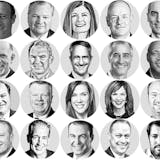After the Vikings closed their practice facility in Eagan in March, Kyle Rudolph found himself with three days to train outside his home at a workout facility that was yet to shut down.
It turned out to be a happy accident that sparked the veteran tight end to buy a piece of equipment that he believes will help him emerge from quarantine as fit as he would be in a normal offseason.
Rudolph stopped in to Exos Minneapolis, where he had trained before the Vikings opened their expansive facility in 2018, and found the Timberwolves had just installed two units of Tonal, a smart home gym that uses digital weights and artificial intelligence-based training programs. Rudolph had been interested in purchasing one for his wife, Jordan, to use at their home in Plymouth, but after he was able to try the program out in Minneapolis, he knew it could help him train for his 10th NFL season as well.
He's been training with it at home for two weeks now; the quality of the workouts, he said, are in line with what he's typically had at the Vikings' facility.
"It really does allow me to get that same work I'm accustomed to getting," Rudolph said. "I don't have to bring in a bunch of free weights and barbells and dumbbells; anything that I would be doing at the facility with that equipment, I'm able to do on the Tonal."
Rudolph's improvisation is one of the ways NFL players are adapting to a pandemic that has disrupted life around the globe and jarred a sports industry built on mechanistic certainty.
The NFL is the only major American sports league yet to postpone games, but with team facilities closed and the league shifting to a "virtual offseason" program, players could soon trade OTAs for more of the DIY training approach.



